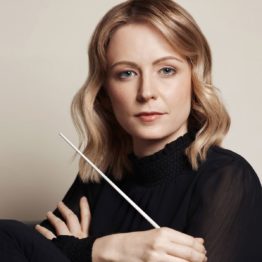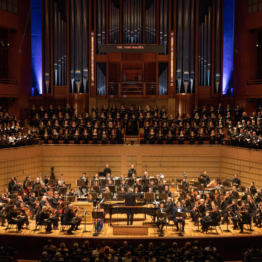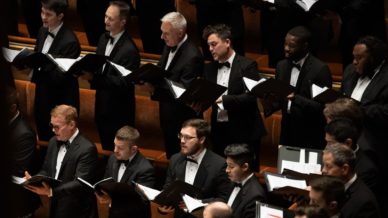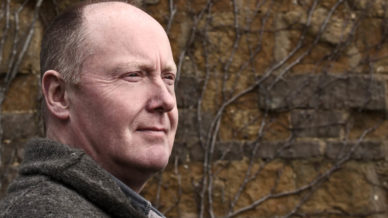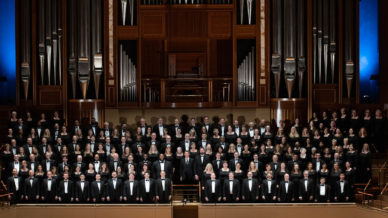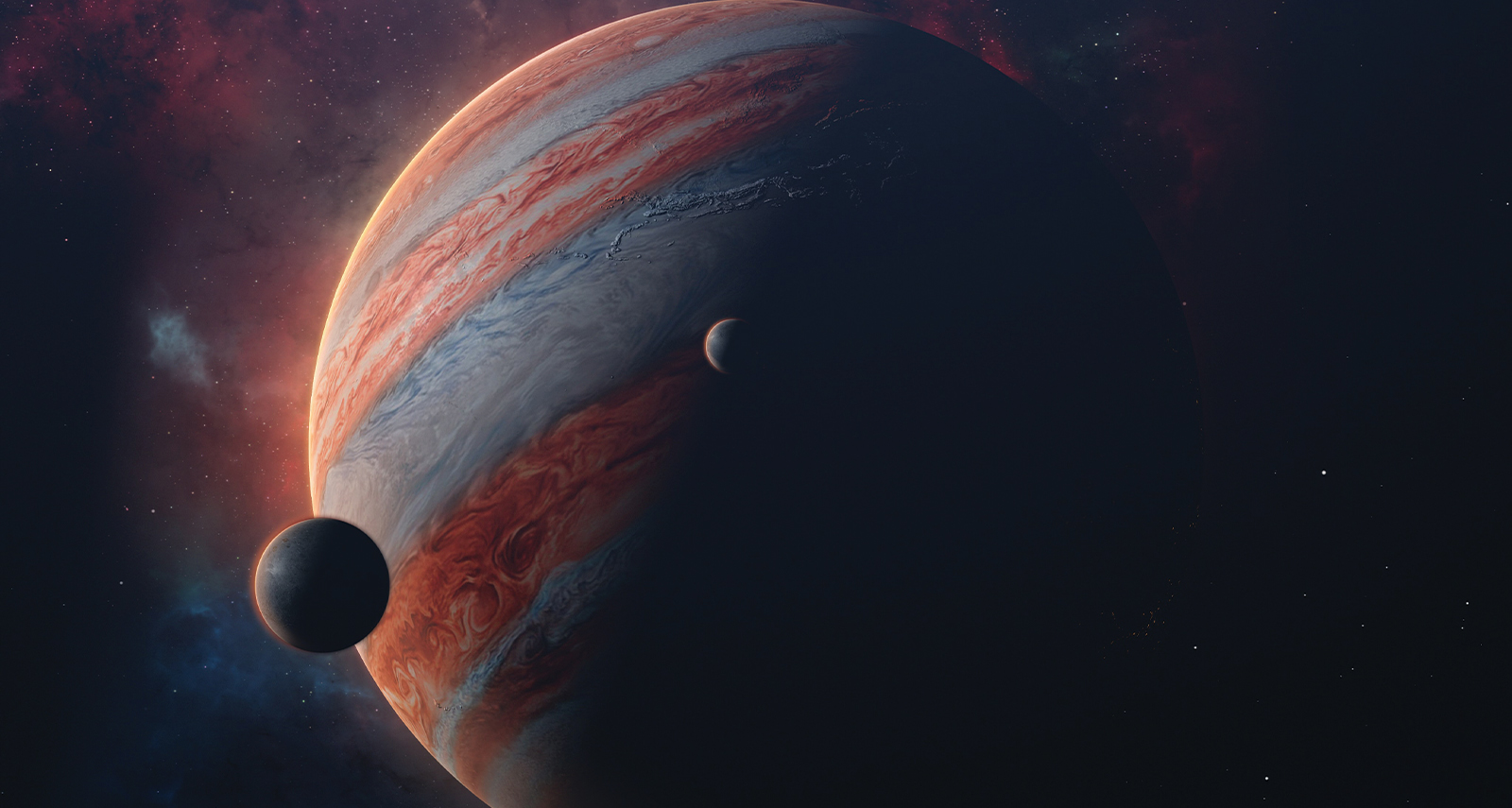

Holst’s The Planets
September 15 – 17, 2022
GEMMA NEW conducts
OLGA KERN piano
WOMEN OF DALLAS SYMPHONY CHORUS
ANGÉLICA NEGRÓN What Keeps Me Awake
RACHMANINOFF Rhapsody on a Theme of Paganini
HOLST The Planets
What Keeps Me Awake, a probing and wandering soundscape by Puerto Rican-born Angélica Negrón, DSO’s Composer-in-Residence, opens the program. A perfect complement to Holst’s searching epic, this mesmerizing and effusive work brims with invigorating emotion.
What Keeps Me Awake is followed by Rachmaninoff’s piano concerto-esque work, Rhapsody on a Theme of Paganini. Using Paganini’s Caprice No. 24 as the inspiration for an ingenious theme and variations for piano and orchestra, Rachmaninoff creates the 1934 equivalent of a pop-song sampling. Our soloist Olga Kern brings her virtuosic talent to this piece.
The program concludes with another popular classic. From the mighty Mars to the cinematic Jupiter, Holst’s The Planets has inspired sci-fi movie music for generations — most famously, Oscar winner John Williams’s The Imperial March from Star Wars. Holst’s interstellar blockbuster launches with Mars: The Bringer of War, but pulsing drums give way to Venus: The Bringer of Peace. This sweeping epic concludes quietly with Neptune as the women of the Dallas Symphony Chorus lend haunting off-stage vocals in an other-worldly ending certain to induce chills in the Meyerson.
Features the Lay Family Concert Organ.
PERFORMANCE PRELUDES
Join us for special pre- and post-concert talks with Composer-in-Residence Angélica Negrón & Principal Guest Conductor Gemma New! The talks will take place from the stage following Thursday’s performance and at 6:30 pm before the Friday & Saturday performances.
“Her electricity at the keyboard is palpable, and though she generates from the music itself, as it flows through her fingers it takes on fresh voltage that is unmistakably hers.”
The Washington Post
Program Notes
by René Spencer Saller
Born in San Juan, Puerto Rico, and now based in Brooklyn, New York, Angélica Negrón is the Dallas Symphony Orchestra’s composer-in-residence. The multi-instrumentalist, composer, educator and music journalist has written numerous works for chamber ensembles and orchestras, as well as film scores and assorted pieces for accordions, toys and electronic and robotic instruments. Her original compositions have been commissioned and performed by the Bang on a Can All-Stars, Kronos Quartet, loadbang, MATA Festival, Brooklyn Youth Chorus, Sō Percussion and the American Composers Orchestra, among others. As a founding member of the transnational electro-acoustic group Balún, she sings and plays accordion and violin. In 2022 the Hermitage Artist Retreat awarded Negrón the Greenfield Prize, which includes a $30,000 commission and a six-week residency.
Negrón received her early training in piano and violin at the Conservatory of Music of Puerto Rico, where she later studied composition with Alfonso Fuentes. She holds a master’s degree in music composition from New York University, where she studied with Pedro da Silva, and she has completed coursework toward a doctorate in composition at The Graduate Center (City University of New York), under Tania León.
The Composer Speaks
“What Keeps Me Awake is a highly personal piece inspired by events that happened, keeping me from falling asleep at night. I wrote this piece in 2008, and at that time I was really struggling with trying to find my own voice as a composer, and also trying to figure out what it meant for someone like me to be writing for such a massive medium, like an orchestra. This piece is an exploration of and a reflection on the creative process itself, what it feels like to be staring at a blank page, the vulnerability and the anxiety that surrounds the creative process. This piece is also about my journey of trying to find a balance in this internal struggle of following my intuition with this external pressure of feeling like I need to validate myself as a composer. [When I wrote it] I had just recently moved from Puerto Rico, which is where I was born and raised, to New York, and as a Latina composer, navigating new spaces that have historically mostly excluded people who look like me, I somehow felt the need to validate my presence in these new spaces. That’s something that I no longer feel, thankfully, but it felt very real at that time.
“The piece has four main sections that are constantly being interrupted by new ideas, and these new ideas transform and also overlap with the four main sections of the piece. The ending of the piece is a little bit up in the air, sustaining the idea that there is no definite conclusion or answer, just this inevitable push of moving forward.”—Angelica Negrón (transcribed from a videotaped introduction to the 2020 Canadian premiere, performed by the National Arts Centre Orchestra and conducted by Alexander Shelley)
After leaving his native Russia during the 1917 Revolution, Sergei Rachmaninoff launched a lucrative career as a globe-trotting concert pianist. In the 1920s the virtuoso-composer signed a recording contract with the Victor label and released performances of his own original compositions. In the 1930s he bought a secluded lakeside getaway outside of Lucerne, Switzerland, where he could compose in peace. He named the villa Senar, an acronym derived from his and his wife Natalia’s names. Between July 3 and August 18, 1934, while ensconced in Senar, he composed Rhapsody on a Theme of Paganini, Op. 43, intending it as material for his upcoming American concert tour. The premiere took place in Baltimore, on November 7, 1934, with Rachmaninoff on piano and Leopold Stokowski leading the Philadelphia Orchestra.
Dazzle and Doom
Rhapsody on a Theme of Paganini is a Russian ex-pat’s take on the most famous riff by violinist-composer Niccolò Paganini. Among other scandalous acts, the infamous Italian virtuoso supposedly sold his soul to the devil in exchange for superhuman musical chops. (Many years later, the Delta blues legend Robert Johnson inspired similar rumors.) Paganini was the first Romantic virtuoso—and arguably the first rock star, too. His brooding, black-clad theatrics and fearsome technical skills influenced Franz Liszt and generations of other subversive showmen.
Composed for solo piano and orchestra, Rhapsody on a Theme of Paganini resembles a piano concerto in many respects, although it’s technically a theme-and-variation work. In a 2013 appreciation published in The Guardian, the pianist Stephen Hough called it “a formal miracle: a set of 24 variations held together as if it were a mini piano concerto, but with the carefree unfolding of a rhapsody.” The music is based on Paganini’s 24th Caprice for unaccompanied violin, a piece that had already spawned variations by other major composers, including Liszt, Robert Schumann and Johannes Brahms.
Somewhat counterintuitively, Rachmaninoff doesn’t state Paganini’s theme outright until after the introduction and first variation: it’s a bare-bones sketch in the beginning, recognizable only in hindsight. In Variations 7, 10, and 24, Rachmaninoff quotes from the theme of the Dies irae (Day of Wrath) plainchant, from the Latin Mass for the Dead—a possible nod to Paganini’s proto-goth stage persona. Structurally, the doomy Dies irae motif unifies the variations, placing them in musical territory that Rachmaninoff had already explored in his 1909 tone poem The Isle of the Dead. By 1940, when he wrote his Symphonic Dances, quoting from the Dies irae had become his signature.
Although the Rhapsody is performed without pause, it can be perceived in three sections, corresponding to the three movements of a concerto: a spirited first movement, consisting of Variations 1 through 10; a slow movement (Variations 11–18); and a joyous finale (Variations 19–24). All of the variations are in A minor except 12 and 13 (D minor); 14 and 15 (F Major); 16 and 17 (B-flat minor); and the flowing, songlike, instantly recognizable Variation 18 (D-flat Major), which ingeniously inverts the Paganini theme.
In 1914, when he began writing The Planets, Gustav Holst was nearly 40 years old and virtually unknown. The shy and severely myopic composer had spent the past nine years directing the music department at St. Paul’s Girls’ School, in Hammersmith, West London. His obscurity suddenly ended in 1918, when Adrian Boult led the Queen’s Hall Orchestra in the premiere of this seven-movement symphonic suite. Almost overnight, Holst was a celebrity—a condition that never suited him. “If nobody likes your work,” he once remarked, “you have to go on just for the sake of the work, and you are in no danger of letting the public make you repeat yourself.” But Holst managed to resist the pull of popular demand. He remained at St. Paul’s for the rest of his life, and he never returned to the subject of planets, even after Pluto was discovered in 1930. (It’s probably just as well, given its demotion to dwarf planet in 2006.)
Holst had many esoteric interests, which shaped his musical language, or vice versa. “As a rule,” he noted, “I only study things which suggest music to me.” The Planets, his best-known composition, is a case in point. For years he had been fascinated by astrology. In the summer of 1913, during a hiking trip in Spain, his friend Clifford Bax suggested that he write a large-scale orchestral piece based not on the planets’ astronomical characteristics but on their astrological and mythological associations.
The suite comprises seven movements because Holst didn’t include Earth, and Pluto hadn’t yet been discovered. But Holst didn’t really care about the latest science, at least where his musical suite was concerned. He arranged the movements according to musical criteria, not orbital proximity. He didn’t need to name a movement after Earth because Earth is everywhere in this suite. These planets reflect us: our star signs, our proxies.
A Closer Listen
The suite opens with “Mars, the Bringer of War,” a punishing quasi-march in 5/4 time that John Williams famously quoted in “The Imperial March” from The Empire Strikes Back. In his directions, Holst recommended that “Mars” be played slightly faster than a regular march to bring out its mechanized, inhuman aspects. Because The Planets was first performed during World War I, many listeners assume that the first movement was a response to the ongoing horrors engulfing Europe. Holst, however, completed it weeks before Austria’s Archduke Franz Ferdinand was assassinated. “Mars” mixes brutal rhythms and spooky effects, such as col legno bowing, where the string players use the wooden side of their bows instead of the usual hair side.
Next, some contrasting calm, as “Venus, the Bringer of Peace” drapes delicate harp glissandi and pastoral winds over a gleaming horn theme. “Mercury, the Winged Messenger” flashes like quicksilver. The folk-infused “Jupiter, the Bringer of Jollity” boasts a central hymnlike passage so hummable that Holst later set the tune to Cecil Spring-Rice’s poem “I Vow to Thee My Country,” creating an instant English anthem. Describing the movement as a whole, Holst wrote, “Jupiter brings jollity in the ordinary sense, and also in the more ceremonial type of rejoicing associated with religions or national festivities.”
“Saturn, the Bringer of Old Age” (Holst’s personal favorite) bristles with dissonance and tolling bells. “Uranus, the Magician” enacts musical sorcery, shape-shifting themes into fresh formal guises. Finally, “Neptune, the Mystic” brings to mind an English Debussy in outer space, with a wordless offstage women’s chorus acting as interplanetary sirens.
